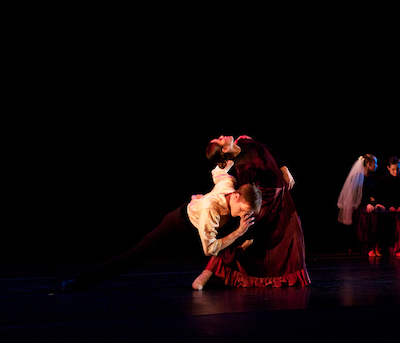By Jack Falk , Special to JTNews
For its fall concert “Until When?” Seattle’s Music of Remembrance promises an enticing mix of music, theatre, and dance, including a newly commissioned choreography to accompany a suite of incidental music for the silent film “Der Golem”; a suite from the Israeli composer who first recorded “Hatikvah”; a song cycle based on the poetry of a Hungarian survivor, with a dramatic reading of the English translation; a 12-year-old violinist whose passion for Jewish music took him to Berlin last summer; and a violin sonata written by a Holocaust victim whose work was banned by the Nazis as “entartete” — degenerate.
According to MOR founder and artistic director Mina Miller, “Until When?” invites listeners to “share in the transformative power of music to move from the depths of human suffering to the healing beauty of hope and renewal.” The concert will be performed Nov. 10 at Benaroya Hall.
Betty Olivero’s “Zeks Yiddishe Lider un Tantz,” a klezmer-inflected suite for clarinet and string quartet, was originally composed for MOR as incidental music for Paul Wegener’s 1927 silent film “The Golem: How He Came into the World.” Olivero captures the legend of the Golem, in which a massive clay creature is brought to life by the wonder-rabbi Judah Loew, to protect the threatened Jewish community of medieval Prague. Olivero’s suite juxtaposes traditional Hebrew melodies with Western contemporary music to evoke the creation of the Golem, tender love scenes, and moments of fire and prayer as the community comes under siege. Miller calls the Golem legend “a metaphor for the struggle to survive during a time of persecution” — a metaphor that was all too familiar to the Jews of Europe so soon after the film’s release.
This performance of Olivero’s suite will serve as the premiere for Pat Hon’s dance composition “Destination Unknown.” Hon’s choreography, which recreates the story of the Golem through dance and movement, will be performed by her students at Seattle’s Cornish College of the Arts.
MOR commissioned Hon’s work after a previous collaboration with Donald Byrd of Spectrum Dance Theatre.
“Working with live performers on stage…was a transformative experience for Donald’s dancers,” Miller said. “We’re eager to give young artists, at an early stage of their careers, the opportunity to collaborate with professional musicians. And “˜The Golem’ is a perfect story to tell through movement.”
Marc Lavry’s “Suite Concertante for Flute, Viola, and Harp” conveys several facets of Israeli music: Pastoral and naïve, lyrical and intimate, rhythmical and energetic. After emigrating to Palestine following a Fascist coup in his native Latvia, Lavry (1903-1967) was eager to toss aside the constraints of European musical composition. The former conductor of the Berlin Symphony Orchestra, Lavry wanted to compose a uniquely Israeli music that would draw upon the sounds of his new land: Sephardic music, Arabic music, the inflections of the Hebrew language, the sounds of the desert, shepherd’s tunes. Inspired by the musical modes, rhythms, and melodies of his new country, Lavry is perhaps best known for “Shir Ha’Emek” (song of the valley), which he wrote almost immediately after his arrival.
The three movements of Lavry’s “Suite Concertante” are based on songs composed by Lavry: Shir Ro’im (a shepherd song), Prayer, and Machol (Dance). The second movement alternates between the past (minor modes that suggest Ashkenazic prayer) and present (major modes that express Lavry’s optimism at living in Israel).
If poetry is indeed “the force of few words,” Israeli composer Eugene Levitas seeks to distill it even further. His song cycle “Until When?” — which lends its name to the concert as a whole — incorporates five short poems by Hungarian-born Holocaust survivor Yaakov Barzilai, none of them longer than five lines.
Barzilai composed more than 130 poems about his experience in Auschwitz. MOR previously presented two song cycles based upon Barzilai’s poetry, which has been set to music by numerous composers. For this program, ACT artistic director Kurt Beattie will introduce each song with a dramatic reading of the corresponding poem in English, enabling the audience to grasp the emotional essence of the performance even without knowing Hebrew, the language in which Barzilai wrote after emigrating from Hungary.
The song cycle will be performed by soprano Karen Early Evans with cellist Walter Grey and Miller on the piano. The composition takes its title from the final poem in the song cycle:
Until when will we be obsessed
With their memory?
Until the very last of them
Is revived.
Each year, MOR chooses a recipient of the David Tonkonogui award, which offers young artists the opportunity to work with professional musicians. The award honors cellist David Tonkonogui, who “believed deeply in human rights and social justice,” according to Miller.
In evaluating applicants, MOR looks for not only outstanding musicianship but also a commitment to humanitarian causes, including a desire to learn about the musical legacy of the Holocaust.
This year’s recipient is 12-year-old violinist Takumi Taguchi. At the MOR concert, Takumi will perform Ernest Bloch’s “Nigun.” As he learned the music, Takumi became inspired to look deeper into the piece and its history and to understand the challenges facing Jewish musicians during the Nazi era. This led him to travel with his parents last summer to visit the Berlin Jewish Museum.
Also on the program is Erwin Schulhoff’s “Sonata No. 2 for Violin and Piano,” which will be performed by Seattle Symphony violinist Mikhail Shmidt with Mark Salman on piano. Schulhoff, an audacious Czech-Jewish composer whose avant-garde work was banned by the Nazis as “degenerate,” drew upon his familiarity with jazz and folkloric themes.
